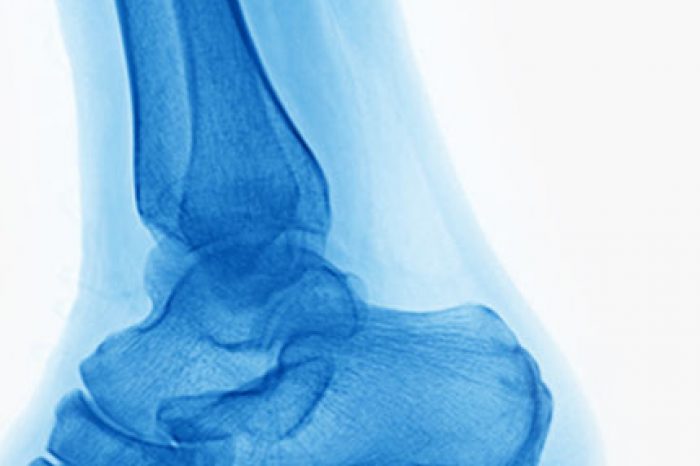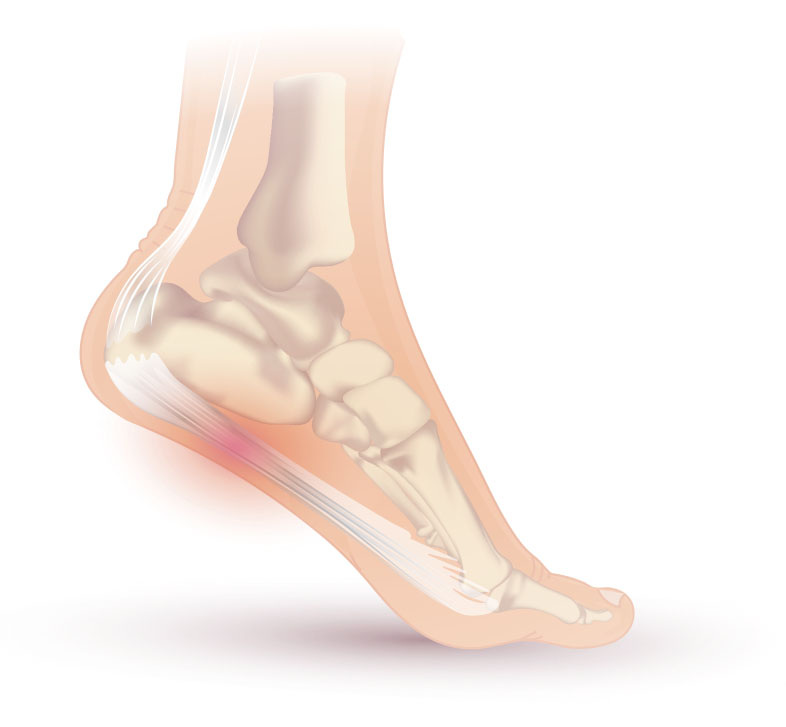What are the Causes of Plantar Fasciitis?
Plantar fasciitis often results from excessive strain or stress on the plantar fascia, leading to small tears and inflammation. Some common causes include:
- Biomechanical Factors:
Abnormal foot mechanics such as pes planus (flat feet) and pes cavus
(high arches) can contribute to plantar fasciitis by altering the
distribution of weight and increasing stress on the plantar fascia [Rabadi et al, 2022; Wearing et al, 2006].
- Overuse & High-Impact Activities: Occupations or activities that involve prolonged standing, walking, or running, especially on hard surfaces, can lead to plantar fasciitis. This is particularly relevant for assembly-line workers and runners. [Martin et al, 2014; Goff & Crawford, 2011].
- Prolonged Weight-Bearing Activities:
Occupations or activities that involve prolonged standing, walking, or
running, especially on hard surfaces, can lead to plantar fasciitis.
This is particularly relevant for assembly-line workers and runners [Martin et al, 2014].
- Obesity or Weight Gain: Increased body mass index (BMI) is strongly associated with plantar fasciitis, particularly in non-athletic populations. Obesity increases the mechanical load on the plantar fascia, leading to microtears and degeneration. [Martin et al, 2014].
- Tight Calf Muscles or Achilles Tendon: A tight Achilles tendon can increase tension on the plantar fascia, contributing to the development of plantar fasciitis. This reduces ankle range of motion in dorsiflexion has been identified as a significant risk factor. Individuals with less than or equal to 0 degrees of dorsiflexion have a markedly increased risk [Gill, 1997; Riddle et al, 2003].
- Age and Degenerative Changes: Middle-aged individuals are more prone to plantar fasciitis due to age-related degenerative changes in the plantar fascia [Gill, 1997].
What are the Symptoms of Plantar Fasciitis?
The most common signs of plantar fasciitis include:
- Stabbing, nonradiating pain
localized to the proximal medioplantar surface of the foot,
particularly noticeable with the first steps in the morning or after
periods of prolonged rest [Trojian & Tucker, 2019; Thomas et al, 2010; Goff & Crawford, 2011].
- Pain that decreases after a few minutes of activity but tends to worsen again by the end of the day, especially after prolonged weight-bearing activities [Trojian & Tucker, 2019; Thomas et al, 2010].
- Tenderness to palpation at the anteromedial aspect of the calcaneus, where the plantar fascia inserts [Trojian & Tucker, 2019; Thomas et al, 2010; Goff & Crawford, 2011].
- Pain elicited by passive dorsiflexion of the ankle and toes, which stretches the plantar fascia [Goff & Crawford, 2011].
- Associated findings may include a high body mass index (BMI), tightness of the Achilles tendon, and inappropriate footwear, which can exacerbate symptoms [Thomas et al, 2010; Goff & Crawford, 2011].
What are the Treatment Options for Plantar Fasciitis?
Most cases improve with conservative treatments, though severe cases may require medical intervention.
Non-Surgical Treatments:
- Rest & Ice Therapy: Reducing activities that exacerbate pain, such as prolonged standing or running [Goff & Crawford, 2011].
- Stretching & Strengthening Exercises: Stretching the calf muscles, Achilles tendon, and plantar fascia can relieve tightness [Trojian & Tucker, 2019; Thomas et al, 2010].
- Footwear & Orthotics: Supportive shoes or arch-support insoles can help distribute pressure evenly [Thomas et al, 2010].
- Massage & Rolling Techniques: Using a foam roller or a frozen water bottle to massage the arch [Trojian & Tucker, 2019].
- Over-the-Counter Pain Relief: NSAIDs like ibuprofen can help manage pain and inflammation [Thomas et al, 2010].
- Physical Therapy: A therapist can guide you through specialized stretching and strengthening exercises [Thomas et al, 2010].
- Corticosteroid Injections: For persistent pain, steroid injections can help reduce inflammation [Thomas et al, 2010].
- Night Splints – Wearing a splint while sleeping keeps the plantar fascia stretched [Thomas et al, 2010].
- Shockwave Therapy – Uses sound waves to stimulate healing in chronic cases [Guimarães et al, 2023; Li et al, 2018; Cooper, 2023].
How do you Prevention Plantar Fasciitis?
- Wear proper footwear with arch support and cushioning.
- Stretch your calves and feet regularly, especially before and after exercise.
- Avoid walking barefoot on hard surfaces for long periods.
- Maintain a healthy weight to reduce stress on your feet.
- Replace worn-out shoes to ensure continued support.
Final Thoughts
Plantar fasciitis is a common but manageable condition. Early intervention with proper care, stretching, and supportive footwear can significantly improve symptoms.
References
- Cooper MT. Common Painful Foot and Ankle Conditions: A Review. JAMA. 2023 Dec 19;330(23):2285-2294.
- Gill LH. Plantar Fasciitis: Diagnosis and Conservative Management. J Am Acad Orthop Surg. 1997 Mar;5(2):109-117.
- Goff JD, Crawford R. Diagnosis and treatment of plantar fasciitis. Am Fam Physician. 2011 Sep 15;84(6):676-82.
- Guimarães JS, Arcanjo FL, Leporace G, Metsavaht LF, Conceição CS, Moreno MVMG, Vieira TEM, Moraes CC, Gomes Neto M. Effects of therapeutic interventions on pain due to plantar fasciitis: A systematic review and meta-analysis. Clin Rehabil. 2023 Jun;37(6):727-746.
- Li H, Lv H, Lin T. Comparison of efficacy of eight treatments for plantar fasciitis: A network meta-analysis. J Cell Physiol. 2018 Jan;234(1):860-870.
- Martin RL, Davenport TE, Reischl SF, McPoil TG, Matheson JW, Wukich DK, McDonough CM; American Physical Therapy Association. Heel pain-plantar fasciitis: revision 2014. J Orthop SportsPhys Ther. 2014 Nov;44(11):A1-33.
- Rabadi D, Seo S, Wong B, Chung D, Rai V, Agrawal DK. Immunopathogenesis, early Detection, current therapies and prevention of plantar Fasciitis: A concise review. Int Immunopharmacol. 2022 Sep;110:109023.
- Riddle DL, Pulisic M, Pidcoe P, Johnson RE. Risk factors for Plantar fasciitis: a matched case-control study. J Bone Joint Surg Am. 2003 May;85(5):872-7.
- Thomas JL, Christensen JC, Kravitz SR, Mendicino RW, Schuberth JM, Vanore JV, Weil LS Sr, Zlotoff HJ, Bouché R, Baker J; American College of Foot and Ankle Surgeons heel pain committee. The diagnosis and treatment of heel pain: a clinical practice guideline-revision 2010. J Foot Ankle Surg. 2010 May-Jun;49(3 Suppl):S1-19.
- Trojian T, Tucker AK. Plantar Fasciitis. Am Fam Physician. 2019 Jun 15;99(12):744-750.
- Wearing SC, Smeathers JE, Urry SR, Hennig EM, Hills AP. The pathomechanics of plantar fasciitis. Sports Med. 2006;36(7):585-611.

